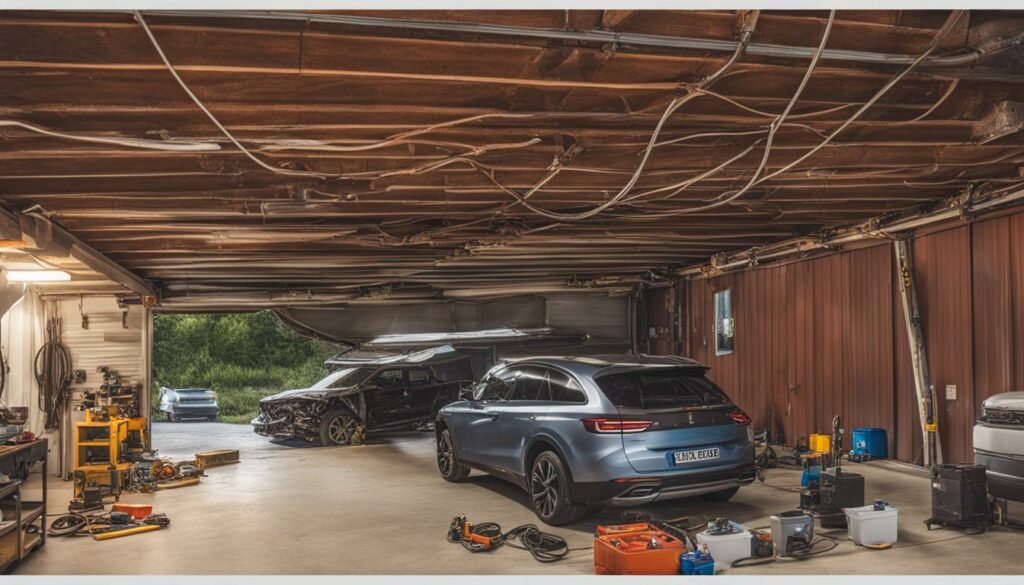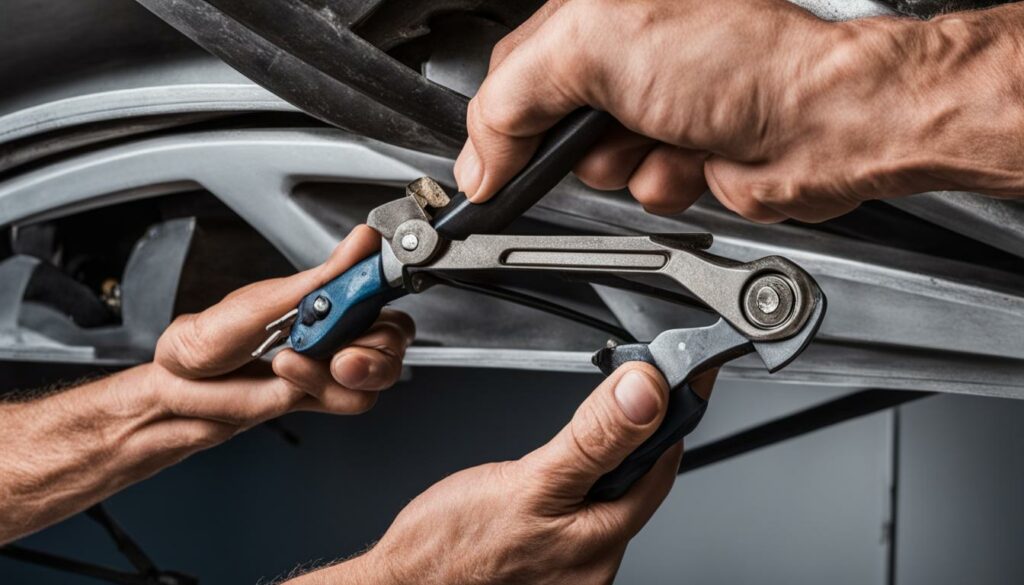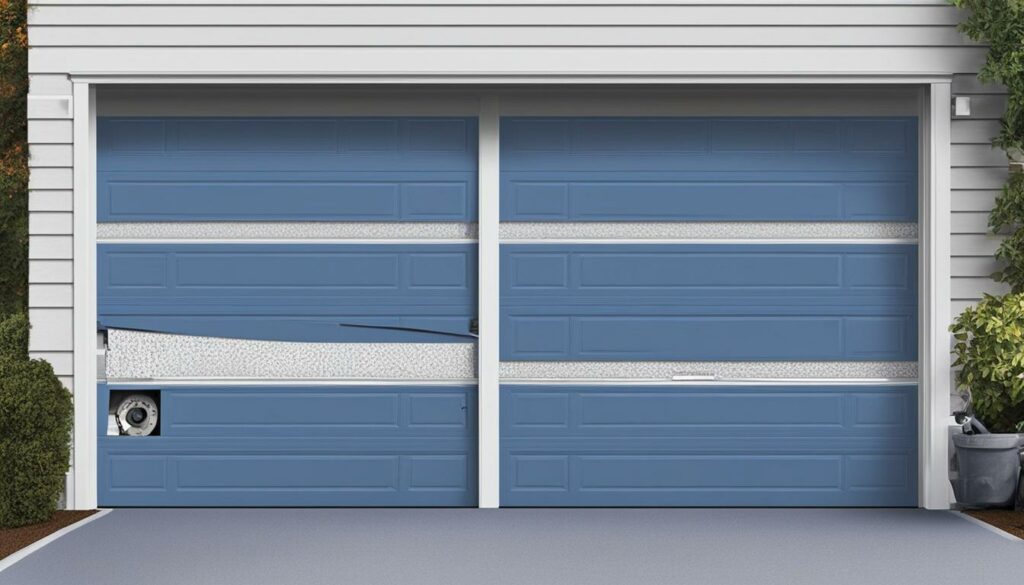Welcome to our comprehensive guide on troubleshooting and identifying common issues with your garage door. As an essential component of your home, it’s crucial to ensure that your garage door operates smoothly and securely. In this section, we will provide you with valuable insights and tips to help you navigate garage door problems effectively.
Whether you’re dealing with a door that won’t open or close, a noisy mechanism, a door off track, broken springs, damaged panels, or sensor malfunctions, we’ve got you covered. By understanding the various types of garage doors and their unique issues, you will be able to diagnose and repair your garage door efficiently.
Key Takeaways:
- Identifying common garage door problems is essential for effective troubleshooting.
- Understanding the different types of garage doors helps in choosing the right solution for your needs.
- Regular maintenance and timely repairs are crucial for ensuring the proper functioning and longevity of your garage door.
- If you’re unsure or uncomfortable with any repairs, it’s always best to consult a professional garage door repair service.
- By following our guide, you’ll gain the confidence and knowledge to address common garage door issues effectively.
Types of Garage Doors
When it comes to choosing a garage door for your home, there are several types to consider. Each type has its own unique features and benefits. Let’s take a closer look at the different types of garage doors available on the market:
1. Sectional Garage Doors
Sectional garage doors are the most popular choice among homeowners. They consist of multiple panels that slide up and overhead, allowing for maximum space utilization both inside and outside the garage. This design makes sectional garage doors suitable for various garage sizes.
2. Roller Garage Doors
Roller garage doors are compact and space-efficient. They consist of horizontal slats that roll up into a bundle at the top of the garage opening. Roller garage doors are easy to operate, provide excellent insulation, and are a great option for homes with limited ceiling space.
3. Up and Over Garage Doors
Up and over garage doors are a traditional and classic choice. They are made of a single panel that swings up and outwards, sliding along a track on the ceiling. Up and over garage doors offer a timeless look and are available in various materials, including wood, steel, and aluminum.
4. Side-Hinged Garage Doors
Side-hinged garage doors open and close like a regular door, swinging outwards horizontally. They are a practical option for garages that require frequent pedestrian access or have limited headroom. Side-hinged garage doors can be customized with different styles and materials.
5. Tilt-Up Canopy Garage Doors
Tilt-up canopy garage doors have a single, solid panel that tilts up and outwards, while a portion of the door extends beyond the opening to form a canopy. These doors provide a clean and simple aesthetic and are relatively easy to install. Tilt-up canopy doors are suitable for garages with ample headroom.
6. Tilt-Up Retractable Garage Doors
Tilt-up retractable garage doors operate similarly to tilt-up canopy doors, but instead of creating a canopy, they retract entirely into the garage. This design allows for maximum ceiling space utilization and offers a wider opening for vehicles. Tilt-up retractable garage doors are durable and low-maintenance.
Now that you’re familiar with the different types of garage doors available, you can make an informed decision based on your specific needs and preferences. Whether you prioritize space efficiency, convenience, or traditional aesthetics, there is a garage door type that meets your requirements.
| Garage Door Type | Advantages | Disadvantages |
|---|---|---|
| Sectional Garage Doors | Maximizes space, suitable for different garage sizes | Higher initial cost |
| Roller Garage Doors | Compact, excellent insulation | Restricted design options |
| Up and Over Garage Doors | Timeless look, available in various materials | Requires more clearance space |
| Side-Hinged Garage Doors | Easy pedestrian access, customizable | Reduced ceiling clearance |
| Tilt-Up Canopy Garage Doors | Clean aesthetic, relatively easy installation | Requires ample headroom |
| Tilt-Up Retractable Garage Doors | Utilizes maximum ceiling space, wider opening | Limited visual design options |
Common Garage Door Problems
Your garage door is a crucial part of your home’s functionality and security. However, like any mechanical system, it can experience common problems that require attention and repair. By identifying these issues promptly, you can ensure the continued smooth operation of your garage door and avoid potential accidents or inconvenience.
Door Won’t Open or Close
One of the most frustrating issues is when your garage door refuses to open or close. This problem can stem from various causes, such as malfunctioning sensors, broken cables, or issues with the garage door opener. Start by checking if there is an obstruction blocking the door’s path. If not, inspect the sensors and ensure they are aligned and clean. If the problem persists, it’s best to consult a professional technician to diagnose and fix the issue.
Noisy Door
A noisy garage door can indicate worn-out rollers, loose hardware, or lack of lubrication. Regular maintenance, such as lubricating the moving parts and tightening loose screws, can help reduce the noise. However, if the noise persists, it may be necessary to replace the rollers or seek professional assistance.
Door Off Track
If your garage door has come off its track, it can be a safety hazard and prevent the door from opening or closing properly. Attempting to fix this issue yourself can be dangerous, as garage doors are heavy and complex systems. It’s crucial to contact a professional technician who has the expertise and tools to realign the door safely and restore its functioning.
Broken Springs
The springs play a vital role in balancing the weight of the garage door, making it easier to open and close. If you notice a broken spring or if the door feels heavier or unevenly balanced, it’s important to avoid operating the door and contact a professional technician. Attempting to replace garage door springs without proper knowledge and equipment can lead to severe injury.
Damage Panels
Accidental impacts or extreme weather conditions can cause damage to your garage door panels. If the damage is minor, you may be able to repair it by replacing the affected panel. However, extensive damage may require replacing the entire door. Consulting a professional technician will help you determine the best course of action.
Sensor Problems
Garage doors are equipped with safety sensors that detect any obstructions in the door’s path. If the door keeps reversing or doesn’t close properly, there may be an issue with the sensors. Check for any obstructions, ensure the sensors are properly aligned, and clean them regularly. If the problem persists, it’s advisable to seek professional assistance to avoid compromising the safety features of your garage door.
By being aware of these common garage door problems and their potential causes, you can take the necessary steps to troubleshoot and address them. However, it’s important to remember that working with garage doors can be dangerous, and certain repairs should be left to professionals with the expertise and knowledge to ensure your safety and the optimal functioning of your garage door.

Tips for Garage Door Repair
Once you have identified the problem with your garage door, it’s time to repair it. This section will provide you with tips for repairing common garage door issues.
1. Check the Springs
Start by checking the springs of your garage door. Springs play a crucial role in its operation, and if they are damaged or worn out, they may need to be replaced. Look for signs of rust, deformation, or excessive wear. If you notice any issues with the springs, it’s best to seek professional assistance to ensure safe and proper repair.
2. Inspect the Tracks
Inspect the tracks to ensure they are aligned and free from any obstructions. Misaligned or dirty tracks can cause your garage door to malfunction. Use a level to check the alignment and a soft brush to remove any debris. If the tracks appear to be damaged or heavily worn, they might need to be replaced.
3. Lubricate Moving Parts
Keeping the moving parts of your garage door well-lubricated is essential for smooth and quiet operation. Apply a silicone-based lubricant to the rollers, hinges, tracks, and springs. Regular lubrication can help prevent rust, reduce friction, and extend the lifespan of your garage door components.
4. Check the Opener
The garage door opener is responsible for the automatic operation of your door. Check the opener’s batteries, wiring, and functionality. Make sure the remote control and keypad are working properly. If you encounter any issues with the opener, consult the manufacturer’s manual or contact a professional for assistance.
5. Replace Damaged Panels
If your garage door panels are damaged or dented, they not only affect its aesthetic appeal but can also compromise its functionality. Consider replacing damaged panels to ensure your garage door operates smoothly and maintains its appearance. Consult a professional for assistance in selecting and installing the right panels for your door.
6. Perform Regular Maintenance
Last but not least, regular maintenance is key to preventing future problems with your garage door. Schedule routine inspections, clean the tracks, lubricate the moving parts, and test the door’s balance and safety features. By maintaining your garage door properly, you can prolong its lifespan and minimize the need for frequent repairs.
Follow these garage door repair tips, and you’ll be well-equipped to address common issues and keep your garage door in optimal condition.
How to Repair a Roller Garage Door
If you have some DIY garage door repair experience and want to tackle the repair of your roller garage door yourself, follow these general steps to get started. However, please note that repairing a roller garage door may require professional expertise, so if you’re unsure or uncomfortable, it’s always best to consult a professional garage door repair service for assistance.
1. Inspect the Door
Begin by thoroughly inspecting your roller garage door to identify any issues or damage. Look for damaged slats, loose hardware, or any other visible problems that may need attention.
2. Replace Damaged Slats
If you notice any damaged slats on your roller garage door, it’s important to replace them as they may compromise the performance and security of the door. Remove the damaged slats and replace them with new ones, ensuring they fit securely and align properly.
3. Tighten Loose Hardware
Over time, the hardware on your roller garage door may become loose due to regular use or vibration. Check all hinges, screws, and bolts and tighten any that are loose. This will help keep your door stable and functioning properly.
4. Clean Tracks
Dirty or debris-filled tracks can prevent your roller garage door from operating smoothly. Use a damp cloth or brush to clean the tracks thoroughly, removing any dirt, dust, or obstructions that may hinder the door’s movement.
5. Lubricate Moving Parts
To ensure smooth and quiet operation, lubricate the moving parts of your roller garage door. Apply a silicone-based lubricant to the hinges, rollers, and other moving components to reduce friction and prevent wear and tear.
6. Test the Door
After completing the repairs and maintenance tasks, it’s important to test your roller garage door to ensure it’s functioning properly. Open and close the door several times to check for any abnormal noises, sticking, or other issues. If you notice any problems, revisit the previous steps and make any necessary adjustments.
Remember, if you’re unsure or uncomfortable with any aspect of the repair or maintenance process, it’s always best to seek professional help. Properly maintaining and repairing your roller garage door will help extend its lifespan and ensure reliable performance for years to come.

Conclusion
In conclusion, taking care of your garage door through regular maintenance and addressing repair issues promptly is essential for ensuring its proper functioning and prolonging its lifespan. By following the garage door problem identification guide and implementing the tips provided, you can effectively troubleshoot and fix common issues that may arise with your garage door.
Remember, prevention is key, and performing regular maintenance tasks such as inspecting the springs, tracks, and opener, as well as lubricating the moving parts, can help prevent potential problems from occurring.
However, if you find yourself unsure or uncomfortable with any aspect of garage door maintenance or repair, it is always best to seek the assistance of a professional garage door repair service. They have the expertise, experience, and tools necessary to handle any garage door issue efficiently and safely.
By prioritizing garage door maintenance and promptly fixing any issues that arise, you can ensure the continued smooth operation of your garage door and the security of your belongings.

